• Maintains feed intake particularly under conditions of enhanced challenge.
• Supports poultry gut health and resilience to stress over periods of enhanced stress.
• Demonstrated improvements to technical performance.
• A highly reliable phytogenic solution for poultry species based on quality and science.
Biostrong® Protect is designed to keep birds in optimal condition especially in phases where enhanced health challenges are foreseen. Based on natural, phytogenic compounds, such as saponins and a specifically selected blend of essential oils, the components in Biostrong® Protect work in synergy to maintain normal intestinal health and feed intake, thus supporting profitable production under challenge conditions. Supplementing layer, broiler and turkey diets with Biostrong® Protect from the first day of life can help the bird throughout the most critical stages of production.
This large commercial layer trial has been completed in an effort to test the efficacy of Biostrong® Protect to the possible prevention of Spotty Liver Disease and to test any differences in resilience and production performance during a SLD break in free-range layers. The trial was run over the summer from September 2019 until April 2020 with treatment starting when the birds reached 18 weeks of age and finishing at 40 weeks of age, data was also collected for performance for 10 weeks after the end of the Biostrong® Protect treatment.
Control and treatment groups from the same flock were moved into separate sheds on the free-range farm at 16 weeks of age. Both sheds were under the same management protocol and received the same basal diet with the treatment group receiving 600g of Biostrong® Protect per MT of feed. Feed intake, performance, mortality and any incidence of a SLD was recorded. The recommended dose of Biostrong® Protect is 400-600g/MT, however, a higher dosage was chosen to mitigate the effects of a spotty liver break during challenging summer conditions.
Results
The birds treated with Biostrong® Protect had a lower mortality, higher rate of lay, overall larger eggs, higher egg mass and slightly higher feed intake for the entire trial period. Dirty eggs were on average lower for the treated group however the first few weeks of treatment were higher than the control. It is thought that an initial adaption period by the gut microflora to the components of the Biostrong® Protect maybe responsible for this initial increase in dirty eggs.
Graph 1: Overall performance differences of the two flocks during the trial until 40 weeks age.
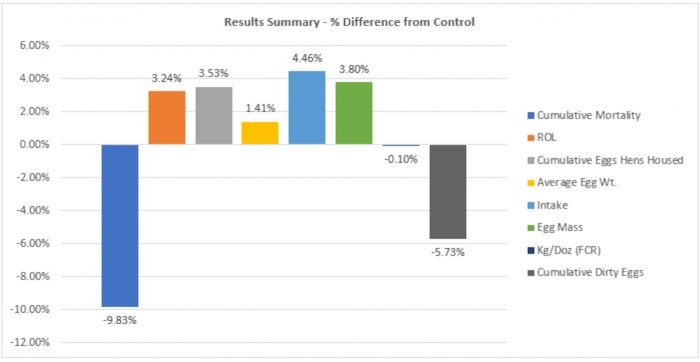
Both groups approached their peak lay from 22 weeks of age, however, the treated group performed with rate of lay above 94% reaching a maximum of 95.8%, for 12 weeks during the 22-week trial period. The control group achieved a maximum rate of lay of 93.9% however only maintained a lay rate above 93% for 2 of the 22-week trial period. During the height of summer outside temperatures reached the low 40°C’s and both the control and treated groups performance suffered. The treated group however still was able to maintain a higher performance during the summer period. Similar trends for mortality were observed over the height of summer, the control group cumulative mortality increases while the treated groups cumulative mortality remains unchanged.
Graph 2: Lay trend for the Control and Biostrong® Protect treated flocks.
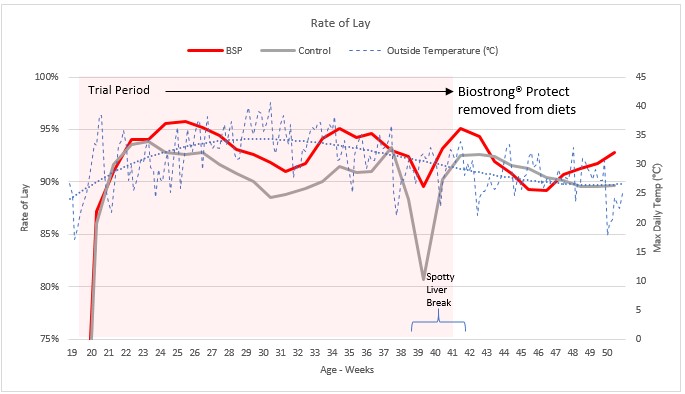
Graph 3: Cumulative mortality all of trial.
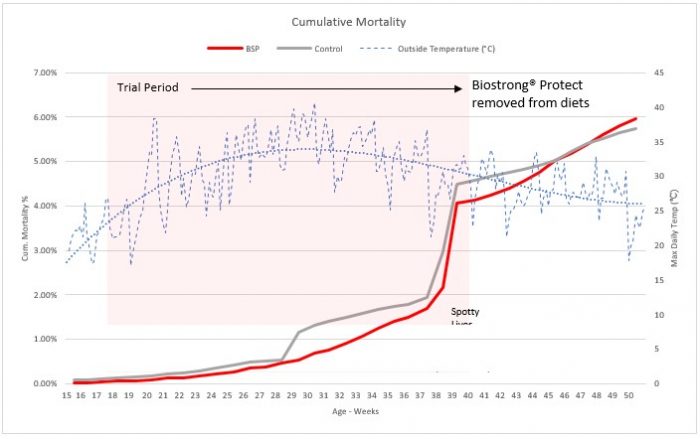
Graph 4: Average Egg Mass all of trial.
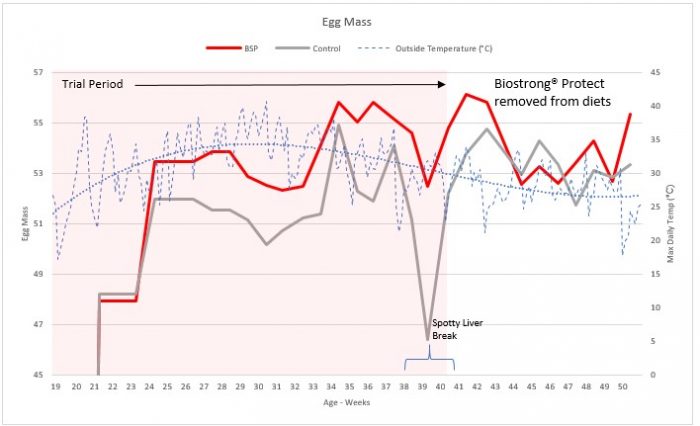
Graph 5: Weekly dirty eggs difference from control all of trial.
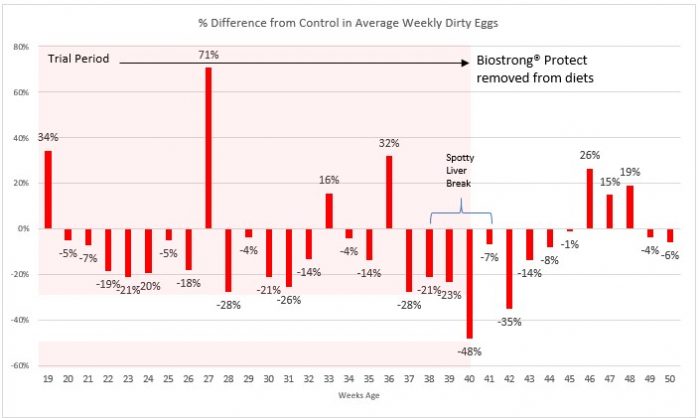
An SLD break occurred in both groups starting during the week of 38 weeks age. Antibiotics were administered to both groups during 38 to 39 weeks of age and both groups had mostly recovered by the end of the 41st week of age. Mortality for the control and treatment groups during the break was similar however intake for the treatment group was maintained resulting in a much higher rate of lay and higher egg mass during the challenge period.
Graph 6: Feed Intake Trend During the Spotty Liver Break.
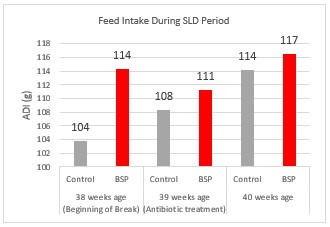
Graph 7: Egg Mass Trend During the Spotty Liver Break.
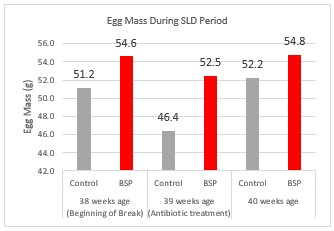
Graph 8: Rate of Lay Trend During the Spotty Liver Break
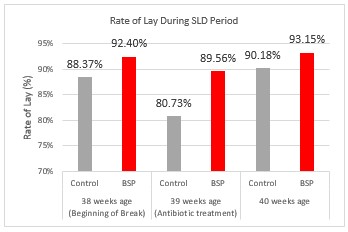
During the SLD break the rate of lay in the control group was substantially reduced from 93% at 37 weeks age down to 88% and as low as 80% for 38 and 39 weeks of age, respectively. In contrast for the treated group, although rate of lay was reduced, the lowest point reached was 89.5% at 39 weeks age. These differences in rate of lay where also reflected in the egg mass trends.
Conclusions
This large commercial layer trial was completed in an effort to test the efficacy of Biostrong® Protect to the possible prevention of Spotty Liver Disease (SLD) and to test any differences in resilience and production performance during a SLD break in free-range layers. The trial has indicated that whilst Biostrong® Protect was not able to prevent a spotty liver outbreak it did however improve the resilience and recovery of the group treated leading to much higher rates of lay, egg weights and egg mass in combination with lower dirty eggs during the SLD challenge period.
It was also demonstrated that Biostrong® Protect fed for the entire trial period developed heavier birds, better performance, higher rates of lay, egg weights and egg mass in combination with lower dirty eggs indicating improved gut health over the control group. Increased mortality of the control group during the peak of summer temperatures, unlike the treated group indicates that the treated group had a better ability to deal with heat stress during that time.
Biostrong® has attained Zootechnical registration in the EU for performance.
Download this article here.

